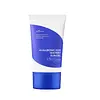What's inside
What's inside
 Key Ingredients
Key Ingredients

 Benefits
Benefits

 Concerns
Concerns

 Ingredients Side-by-side
Ingredients Side-by-side

Water
Skin ConditioningZinc Oxide
Cosmetic ColorantGlycerin
HumectantC12-15 Alkyl Benzoate
AntimicrobialCaprylic/Capric Triglyceride
MaskingStearic Acid
CleansingSodium Hyaluronate
HumectantPotassium Cetyl Phosphate
EmulsifyingInulin Lauryl Carbamate
Emulsion StabilisingPanax Ginseng Root Extract
EmollientAcetyl Hexapeptide-8
HumectantPanthenol
Skin ConditioningAllantoin
Skin ConditioningSodium Benzoate
MaskingPotassium Sorbate
PreservativeXanthan Gum
EmulsifyingLactic Acid
BufferingTetrasodium EDTA
Caprylyl Glycol
EmollientPhenoxyethanol
PreservativeEthylhexylglycerin
Skin ConditioningSodium Hydroxide
BufferingWater, Zinc Oxide, Glycerin, C12-15 Alkyl Benzoate, Caprylic/Capric Triglyceride, Stearic Acid, Sodium Hyaluronate, Potassium Cetyl Phosphate, Inulin Lauryl Carbamate, Panax Ginseng Root Extract, Acetyl Hexapeptide-8, Panthenol, Allantoin, Sodium Benzoate, Potassium Sorbate, Xanthan Gum, Lactic Acid, Tetrasodium EDTA, Caprylyl Glycol, Phenoxyethanol, Ethylhexylglycerin, Sodium Hydroxide
Water
Skin ConditioningButylene Glycol
HumectantEthylhexyl Salicylate
UV AbsorberHomosalate
Skin ConditioningDibutyl Adipate
EmollientNiacinamide
SmoothingBis-Ethylhexyloxyphenol Methoxyphenyl Triazine
Skin ConditioningCyclopentasiloxane
EmollientMethylene Bis-Benzotriazolyl Tetramethylbutylphenol
UV FilterPolysilicone-15
UV FilterDiethylamino Hydroxybenzoyl Hexyl Benzoate
UV Filter1,2-Hexanediol
Skin ConditioningPentylene Glycol
Skin ConditioningPinus Pinaster Bark Extract
AntioxidantCeramide NP
Skin ConditioningCentella Asiatica Extract
CleansingGlycerin
HumectantPortulaca Oleracea Extract
Skin ConditioningHouttuynia Cordata Extract
Skin ConditioningOlea Europaea Fruit Oil
MaskingFicus Carica Fruit Extract
HumectantSodium Hyaluronate
HumectantCeteth-10
EmulsifyingHydrogenated Lecithin
EmulsifyingDecyl Glucoside
CleansingPropanediol
SolventTocopherol
AntioxidantAstaxanthin
Skin ConditioningHyaluronic Acid
HumectantSodium Hyaluronate Crosspolymer
HumectantAscorbyl Propyl Hyaluronate
Skin ConditioningHydrolyzed Hyaluronic Acid
HumectantHydroxypropyltrimonium Hyaluronate
Acrylates/C10-30 Alkyl Acrylate Crosspolymer
Emulsion StabilisingSodium Acetylated Hyaluronate
HumectantHydrolyzed Sodium Hyaluronate
Skin ConditioningAdenosine
Skin ConditioningXanthan Gum
EmulsifyingCetyl PEG/PPG-10/1 Dimethicone
EmulsifyingTromethamine
BufferingCarbomer
Emulsion StabilisingPropylene Glycol
HumectantEthylhexylglycerin
Skin ConditioningWater, Butylene Glycol, Ethylhexyl Salicylate, Homosalate, Dibutyl Adipate, Niacinamide, Bis-Ethylhexyloxyphenol Methoxyphenyl Triazine, Cyclopentasiloxane, Methylene Bis-Benzotriazolyl Tetramethylbutylphenol, Polysilicone-15, Diethylamino Hydroxybenzoyl Hexyl Benzoate, 1,2-Hexanediol, Pentylene Glycol, Pinus Pinaster Bark Extract, Ceramide NP, Centella Asiatica Extract, Glycerin, Portulaca Oleracea Extract, Houttuynia Cordata Extract, Olea Europaea Fruit Oil, Ficus Carica Fruit Extract, Sodium Hyaluronate, Ceteth-10, Hydrogenated Lecithin, Decyl Glucoside, Propanediol, Tocopherol, Astaxanthin, Hyaluronic Acid, Sodium Hyaluronate Crosspolymer, Ascorbyl Propyl Hyaluronate, Hydrolyzed Hyaluronic Acid, Hydroxypropyltrimonium Hyaluronate, Acrylates/C10-30 Alkyl Acrylate Crosspolymer, Sodium Acetylated Hyaluronate, Hydrolyzed Sodium Hyaluronate, Adenosine, Xanthan Gum, Cetyl PEG/PPG-10/1 Dimethicone, Tromethamine, Carbomer, Propylene Glycol, Ethylhexylglycerin
 Reviews
Reviews

Ingredients Explained
These ingredients are found in both products.
Ingredients higher up in an ingredient list are typically present in a larger amount.
Ethylhexylglycerin (we can't pronounce this either) is commonly used as a preservative and skin softener. It is derived from glyceryl.
You might see Ethylhexylglycerin often paired with other preservatives such as phenoxyethanol. Ethylhexylglycerin has been found to increase the effectiveness of these other preservatives.
Glycerin is already naturally found in your skin. It helps moisturize and protect your skin.
A study from 2016 found glycerin to be more effective as a humectant than AHAs and hyaluronic acid.
As a humectant, it helps the skin stay hydrated by pulling moisture to your skin. The low molecular weight of glycerin allows it to pull moisture into the deeper layers of your skin.
Hydrated skin improves your skin barrier; Your skin barrier helps protect against irritants and bacteria.
Glycerin has also been found to have antimicrobial and antiviral properties. Due to these properties, glycerin is often used in wound and burn treatments.
In cosmetics, glycerin is usually derived from plants such as soybean or palm. However, it can also be sourced from animals, such as tallow or animal fat.
This ingredient is organic, colorless, odorless, and non-toxic.
Glycerin is the name for this ingredient in American English. British English uses Glycerol/Glycerine.
Learn more about GlycerinSodium Hyaluronate is hyaluronic acid's salt form. It is commonly derived from the sodium salt of hyaluronic acid.
Like hyaluronic acid, it is great at holding water and acts as a humectant. This makes it a great skin hydrating ingredient.
Sodium Hyaluronate is naturally occurring in our bodies and is mostly found in eye fluid and joints.
These are some other common types of Hyaluronic Acid:
Learn more about Sodium HyaluronateWater. It's the most common cosmetic ingredient of all. You'll usually see it at the top of ingredient lists, meaning that it makes up the largest part of the product.
So why is it so popular? Water most often acts as a solvent - this means that it helps dissolve other ingredients into the formulation.
You'll also recognize water as that liquid we all need to stay alive. If you see this, drink a glass of water. Stay hydrated!
Learn more about WaterXanthan gum is used as a stabilizer and thickener within cosmetic products. It helps give products a sticky, thick feeling - preventing them from being too runny.
On the technical side of things, xanthan gum is a polysaccharide - a combination consisting of multiple sugar molecules bonded together.
Xanthan gum is a pretty common and great ingredient. It is a natural, non-toxic, non-irritating ingredient that is also commonly used in food products.
Learn more about Xanthan Gum